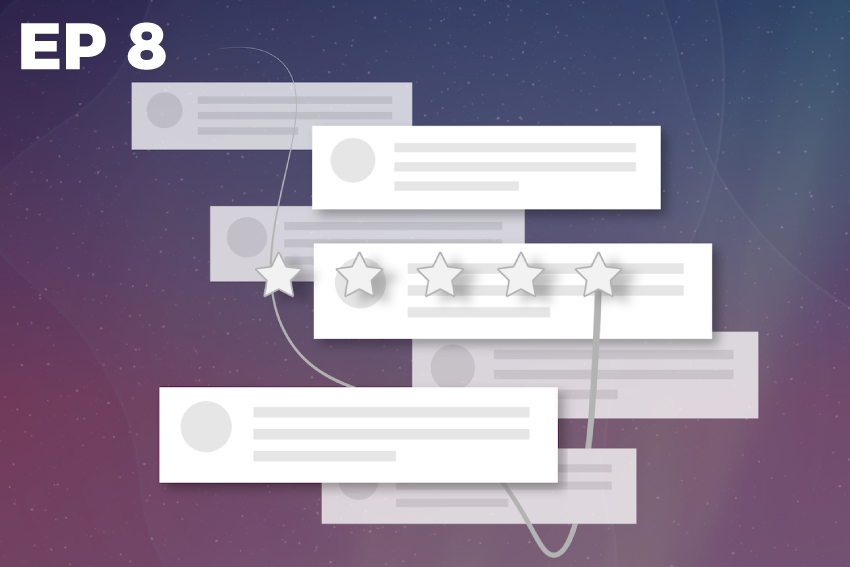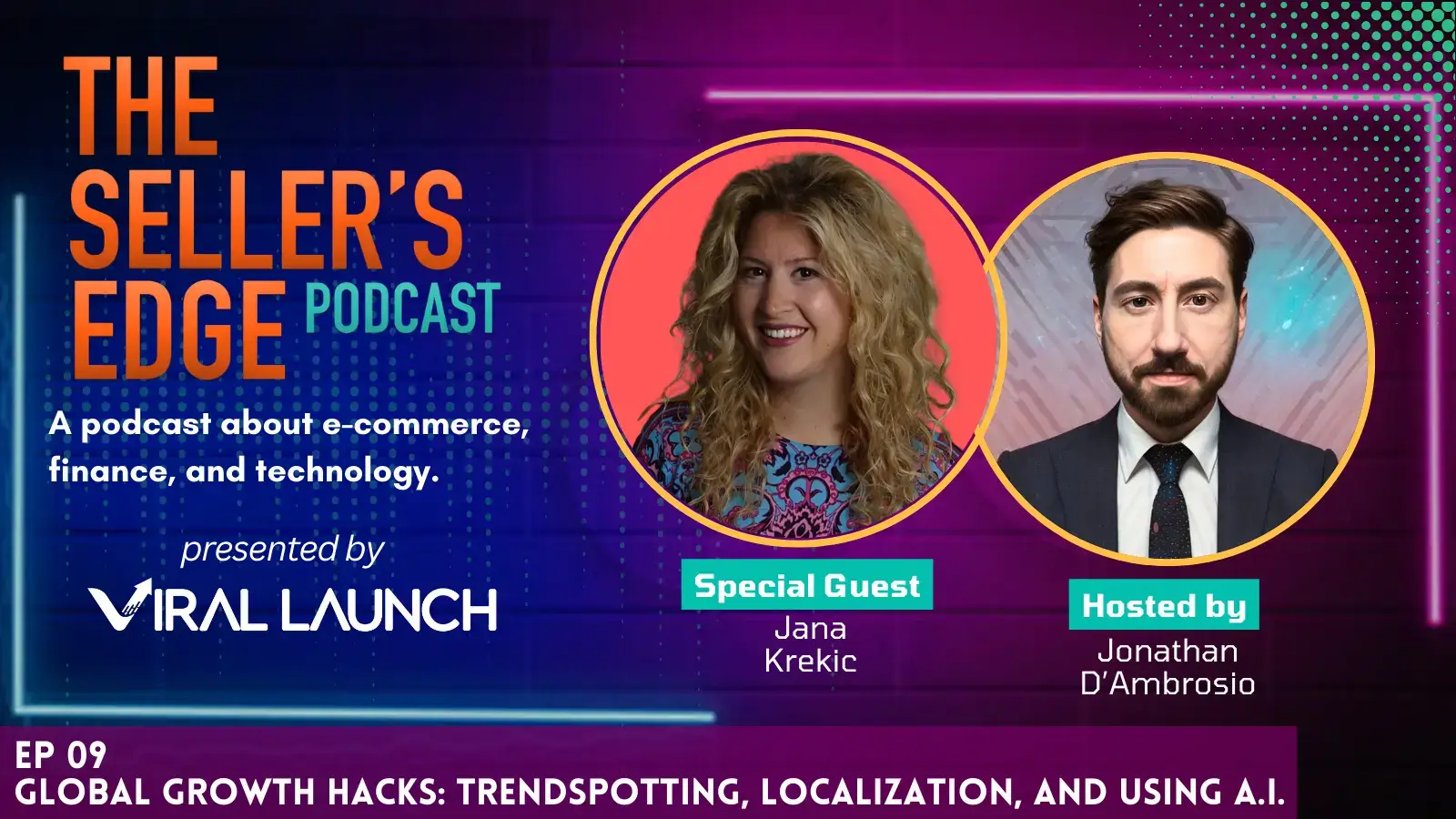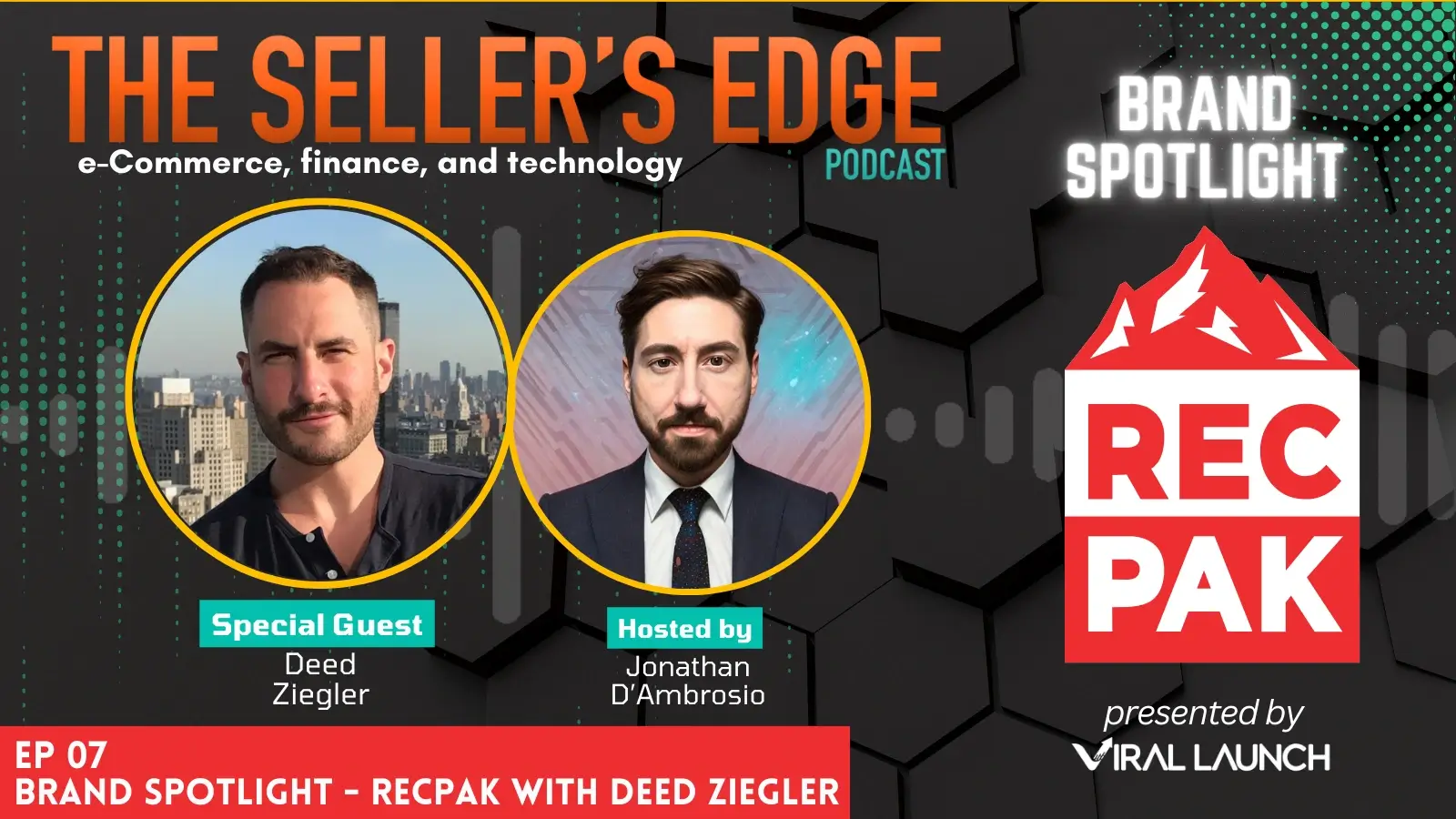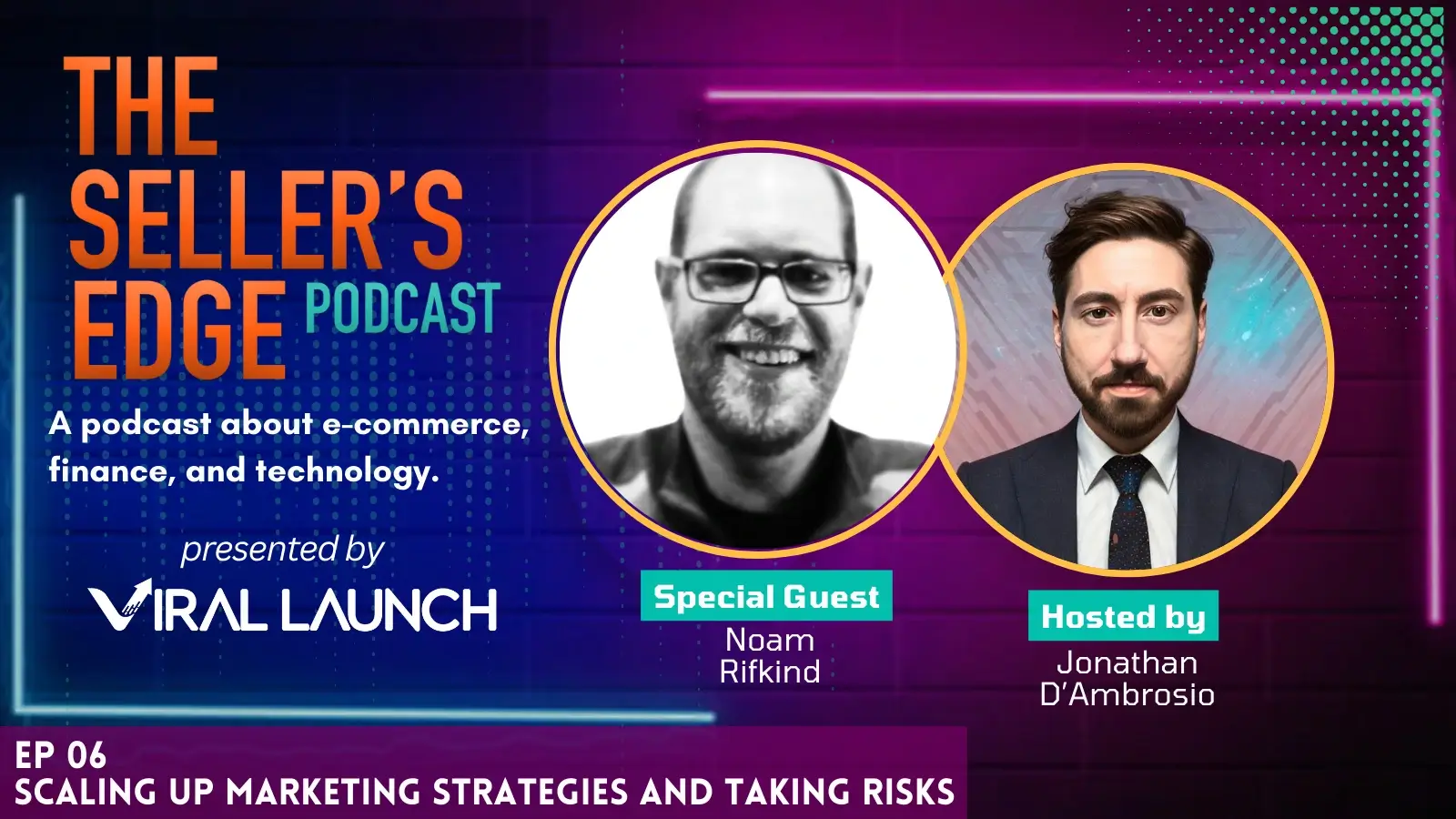Follow the Data Episode 8: Are Amazon Reviews Going to Change?
Reviews can pose a huge threat to the success of new products, and getting legitimate reviews early on can be difficult. Will this barrier to entry stagnate the market and ruin the competitive environment that Amazon shoppers love? Join Viral Launch CEO Casey Gauss and co-host Cameron Yoder as they speculate about the future of Amazon reviews.
Follow the Data Show Notes
- If only you could get to 21 reviews! Then you could really compete. Check out this Seller Sessions video where Brad Moss talks briefly about the study that found conversion rates didn’t improve past 21 reviews.
- LinkedIn uses a model that might work nicely for Amazon reviews in the future. Any connections you make over the 500-mark show up on your profile as 500+. Seems a bit of an unfair system for those of us who are extraordinarily popular or have really killer products. But check out some of the hidden benefits that having more than 500 reviews affords you.
- Amazon’s Early Reviewer Program helps new products get their first 5 reviews and is available as part of their Brand Registry Program. Find out if you are eligible here.
- Reach out to our content team and tell us what you thought of the show. What do you think is in store for Amazon reviews?
Podcast Transcript
CASEY GAUSS:
Reviews are the currency of the Amazon marketplace.
CAMERON YODER:
But is change to Amazon’s current review platform on its way? I’m Cameron Yoder.
CASEY GAUSS:
And I’m Casey Gauss, your host for Follow the Data: Your Journey to Amazon FBA Success. In this show we leverage the data we’ve accumulated at Viral Launch from over 25,000 product launches and our experience working with over 6500 brands to help you understand the big picture when it comes to Amazon and, most importantly, the best practices for success as an Amazon seller.
CAMERON YODER:
Today’s episode is a bit different. We’re going to branch out a bit and talk more conceptually about Amazon’s current review system, how it currently works, potential impacts and flaws and changes that we think might be on the horizon. Let’s get started.
CAMERON YODER:
All right, Casey, so today’s episode is a little bit different. It’s not as data-driven, right, but it’s conceptual, and it’s important. So what are we talking about today?
CASEY GAUSS:
Yeah, you know, in terms of data I would like to think that maybe the data has helped us to build the conceptual model around Amazon.
CAMERON YODER:
Yeah, yeah.
CASEY GAUSS:
I definitely think that the data has helped us to, anyways, build this theory. And so essentially the theory is that, you know, I think in somewhat the mid-term, the short- to mid-term we’re going to have to see Amazon make a systemic review change, and we’re not talking about, you know, not being able to get reviews from discounted promotions or anything small like that. I think –
CAMERON YODER:
Something much bigger.
CASEY GAUSS:
Yeah, yeah, exactly. And so I’m pretty interested to hear what the feedback will be. I imagine something like this will be somewhat polarizing in terms of people seeing our view, as well as maybe a complete opposite view.
CAMERON YODER:
Yeah.
CASEY GAUSS:
And I imagine other people will have probably better thoughts than I do.
CAMERON YODER:
I mean we have – we’ll touch on this again at the end, but again, we have that phone number, and we’ll read the number out at the end of the episode. But if you have an opinion on this, then seriously feel free to call in and tell us what you think, or again, just ask any questions on what we’re going to go over. But first off –
CASEY GAUSS:
Yeah, please. I mean I’d love to hear people’s ideas and feedback because it can help us better lay out our product roadmap so that we’re making sure to help sellers in the best way possible or help us give better advice. So, anyways –
CAMERON YODER:
Exactly.
CASEY GAUSS:
Yeah, so let’s just jump into it. So just as a quick overview of the current review system, the current system, in how it works is essentially obviously someone buys a product.You are able to go and leave a review as a customer. Let’s – we’re talking from the perspective of a customer.
CAMERON YODER:
Right, right.
CASEY GAUSS:
And so these reviews accumulate. And so if you have 10 people review a product, or 10 people review a product, now it has 10 reviews, and the way that a rating is calculated, so a star rating is being shown, the way the rating is calculated is it takes into account recency, and it also takes into account whether or not a review is verified or unverified and puts together some amalgamation or some, you know, average rating, even though it’s not a straight average, rating of that product’s reviews. And so –
CAMERON YODER:
Do we have data on how recent, how far back it goes?
CASEY GAUSS:
No, so we haven’t tried to, you know, reverse engineer the algorithm of reviews, and I – theoretically I imagine it wouldn’t be very difficult to do. There’s just really, you know, no –
CAMERON YODER:
Not too much point?
CASEY GAUSS:
Yeah, yeah, it’s not going to help us. I mean at the end of the day you need to have a great product that people want to leave good reviews on.
CAMERON YODER:
Right.
CASEY GAUSS:
We’re not trying to game reviews. That’s the last thing that we want to do here.
CAMERON YODER:
Right, right.
CASEY GAUSS:
And so there’s at least right now no point.
CAMERON YODER:
Well Casey, you touched on this a little bit. Just to get everyone in kind of on the whole picture of reviews, you can get reviews from someone buying a product on Amazon, right, but that all reviews on the platform might not be from people that have bought the product on Amazon. Explain that a little bit.
CASEY GAUSS:
Yeah, so unverified – so there’s this concept of unverified reviews, which is now there’s two different camps of unverified reviews. Essentially, one, let’s say you bought a product at Walmart and you want to leave a review on Amazon. You can. And that is an unverified review. It’s completely within Amazon’s terms of service, and they actually encourage it. I think the whole reason behind these unverified reviews is it was, especially when Amazon was a young platform, a way of them, you know, bootstrapping and accelerating their review system.
I mean that was one of their initial kind of advantages is they have this review system that buyers know and trust, and that social proof helps them to make better buying decisions in e-commerce, which, you know, five years ago, 10 years ago, which was a very, you know, different situation than it is now. The trust was very difficult that I’m buying something that I haven’t been able to see, you know, touch or feel. So I don’t know the quality. So now I have to trust in this social proof, or these reviews that other people are leaving. And so that’s what really helped to – that’s one thing that helped Amazon to grow.
But anyways, so a new product comes onto the platform. A new brand comes onto the platform that has maybe been doing well in traditional retail or something like that. Well now that brand can get their customers that are buying somewhere else to come leave reviews on Amazon’s platform. That helps Amazon out because now they have more reviews, more social proof around these products which are going to better drive sales, and then also that helps that brand out because, again, they’re going to drive more sales.
CAMERON YODER:
Because as a big brand it wouldn’t really make much sense to, if you have all this social attraction already, if you have all these reviews already, to not be able to bring them on with you. That would just not attract a lot of big sellers that already have those things in place. And so of course having those things in place is going to be able to encourage big brands to come onto Amazon if they’re not already.
CASEY GAUSS:
Right. And so from a buyer’s perspective reviews do two things. One, they act as an indicator of popularity. So buyers are not looking at a bestseller rank. They’re not browsing through the bestseller rank tree.
CAMERON YODER:
Looking at their reviews.
CASEY GAUSS:
Yeah.
CAMERON YODER:
They’re looking at their reviews.
CASEY GAUSS:
So obviously if something has, let’s just say 10,000 reviews, well, at least 10,000 people had to have bought that. So it must be somewhat popular, right? And so versus a product that has 10 reviews. Well, it doesn’t look like as many people bought that. So it must not be popular. There may be some, or must be some reason that I am not aware of which is the reason why not as many people have bought it. Maybe it’s new and not as proven, or maybe it’s just not as good, or maybe people don’t trust the brand. So I am less inclined to go and trust it as well.
CAMERON YODER:
Right.
CASEY GAUSS:
So anyways, acts as an indicator of popularity, and then obviously acts as an indicator of quality. So you know a five-star product with a great number of reviews seems to be of good quality. A product with a two-star rating and a significant number of reviews seems to be a product of low-quality, so I’m less inclined to buy it. And so anyways, reviews, again, act as this form of social proof giving me confidence to buy the product. And so from the customer’s perspective that’s that. From the seller’s perspective, you know, we really see the data around reviews being the barrier to entry. There’s –
CAMERON YODER:
Right.
CASEY GAUSS:
Okay, so this is a little tangent on a myth, but you know, there’s recently these articles coming around where Amazon, Amazon did this internal study and the magic number to reviews is 21, and so – I believe it’s 21.
CAMERON YODER:
Wait, 21 –
CASEY GAUSS:
Reviews.
CAMERON YODER:
What do you mean, to be successful?
CASEY GAUSS:
So yeah, so the myth is if you have – I think it’s 21. Please don’t quote me. It may be 22. It’s somewhere around there.
CAMERON YODER:
It’s like 20s, right?
CASEY GAUSS:
Yeah, so anyways, if a product has 21 reviews it is able to drive, you know, a significant number of sales. And so basically the myth was if a product had – I believe I saw this quote. Again, not verbatim, but if a product had five reviews but an average rating of 4.8 or something like that, it is less inclined to drive sales than a product with 22 reviews – it’s above that threshold – and an average rating of three stars, right?
CAMERON YODER:
Which doesn’t make sense.
CASEY GAUSS:
At least for me, no, it doesn’t.
CAMERON YODER:
Personally, same
CASEY GAUSS:
And again, looking at a bigger market where a product has 10,000 reviews and the other product has 22 reviews, I’m pretty sure that customers are going to treat these different. The reason why I feel this way is, again, because we have the data around it. We’ve put so many products up on page 1 that have like one review, zero reviews, 50 reviews, and everybody else has 10,000 reviews or 1000 reviews, whatever. They had this significantly high review quantity, and we see these, the people with smaller review quantities struggle to sell at market potential because they don’t have a competitive number of reviews.
CAMERON YODER:
Right.
CASEY GAUSS:
The thing is we don’t know this study, right? So we don’t know what variables did they isolate? Which variables did they not take into account? Are these on, you know, products that aren’t ranking, or you know, maybe they are ranking in a small niche. You know, I have no idea. Or they’re highly-dependent on, you know, some product that really pays attention to creatives. I have no idea, so. I didn’t see the study, which makes it hard for me to judge. I have, you know, we’ve run 25,000 launches, and we’ve seen this over and over. Are there extenuating cases? Are there corner cases in which products with low review quantities do well? Oh, of course, and are there ways to mitigate the difference between a product with high review quantity and low review quantity in terms of sales? Oh, of course.
With that from seller’s perspective the way you see reviews largely as one, as a barrier to entry in a market, two, as this thing that is so elusive as Amazon continues to make getting reviews more difficult, legitimately.
So yeah, so kind of just wanted to paint the picture there. Next, we kind of wanted to talk a little bit about flaws of this current system. And so if reviews are really the barrier to entry in a market, well, just as a function of time reviews are going to increase. So let’s say that, you know, just on average page 1 sellers have 1000 reviews,Well, 50 years down the road those products are, those people on page 1 for fish oil, assuming they maintain rank and people continue to buy fish oil, you know, let’s take out all these other variables that we don’t really need to account for for this example. Anyways, they will have 50,000 reviews. Let’s say on average the product gains 1000 reviews a year. Let’s just say. So 50 years from now you’ll have 51,000 reviews. And so if let’s say this brand-new formula for fish oil comes out –
CAMERON YODER:
It’s really good.
CASEY GAUSS:
It’s way better than everything else.
CAMERON YODER:
Fantastic.
CASEY GAUSS:
It’s also half the price, but you launch it on Amazon, and Let’s say I get on page 1 and I have three reviews. And everybody else has 51,000 reviews and they have just as good a rating, or …
CAMERON YODER:
Put yourself – put yourself in that situation. If you’re buying that fish oil, which one are you going to buy? Which one?
CASEY GAUSS:
You know, everybody’s fish oil says it’s amazing, and you know, says it’s the best, the highest-quality, blah, blah, blah.
CAMERON YODER:
Oh, but shoot, 50,000 people have left a review on this one, on average.
CASEY GAUSS:
And here you are with 50 reviews claiming to be a much better version blah, blah, blah. No, no one’s going to trust you because the social proof is saying that these other guys are better. And so this is a problem because it creates stale markets, and especially over time the problem just continues to amplify.
And so there has to be some method that allows new products to break into the market and compete well. And because you just stifle competition, or let’s say everybody kind of starts to decrease the quality of their fish oil to save on margin. Well, they still have 48,000 or whatever, reviews that have that good rating, and yeah, Amazon does take into account recency. But again, these guys have 50-some thousand reviews that are helping to boost that rating. I don’t know, I just think that there’s so many possible scenarios, and all of them lead to this problem of stale markets because review quantity is a major decision-maker in people buying a product.
CAMERON YODER:
Well, and it’s like if you – that’s from a buyer’s perspective, too, but from a seller’s perspective if you are – if you are – this is another perspective to look at – if you’re a seller and you’re selling that fish oil that has 50,000 reviews you’re probably not going to want to re-enter another product into that market because you’re, I mean in a sense you’re kind of trapped.
It’s a good trapped because you’re making a ton of money because you’re locked in at 50,000 reviews, but you don’t want to refresh or do anything that would have you release a new product into that same fish oil market, for example, and all of a sudden you don’t have access to those reviews – like if you release another SKU into that market. You might be trapped into the markets, into the current markets that you’re selling in because of those extremely high review quantities.
CASEY GAUSS:
Yeah, and you know, I could see – there’s probably a million things I can’t even imagine that would happen here, you know. I could definitely see in some markets like the beauty space, I could see one or two brands just going and buying all the private label brands just so that they can dominate page 1 because okay, I mean we’re already seeing it in some of these highly-competitive markets where these guys have just thousands and thousands of reviews. And it’s tough for new brands to come up.
And so if you had two – two companies go and buy, you know, 50% each of the top selling brands in the third-party beauty space right now or private-label beauty space, these guys would essentially own beauty on Amazon and make it extremely difficult for any new sellers to come into the market. And I, again, I just think that competition is what has made Amazon so great. And you’re really decreasing the ability for new competition to come in.
Actually one last flaw – sorry, that I didn’t mention –
CAMERON YODER:
Yeah, yeah, yeah.
CASEY GAUSS:
– is basically because of the current state of the review system, one, it’s so difficult to get, but two, it is, in a lot of markets the currency to doing well or selling at market potential. People, sellers are going to these black hat methods of driving reviews, and generally in this kind of scenario it’s really just an arms race of, hey, there’s a new tactic of getting around reviews and being able to drive black hat reviews. So then Amazon is just incentivized to figure out that tactic and then put some safeguard in place. I mean it’s anything with internet security you build a wall, and then someone builds a bigger ladder, and then you build a bigger wall, and then they build a bigger ladder, or they find a crack in that wall, you patch it, and then they find another crack, and then they patch it, and so it’s this arms race. And then on the consumer side it’s leading to reviews that you cannot trust. And so it’s crazy. I don’t think that there’s one end all solution for that. I think that’s just a feature or function of any kind of market.
CAMERON YODER:
So okay, we’ve kind of broken down what the current system is and how it is impacting everything right now and its potential for impact even a couple years down the line. But, Casey, what do you think is going to change? Like what – if this would continue, obviously the effects would be crazy, just crazy bad for sellers and buyers, I think, as a whole and just the market as a whole. So what do you think is going to change? Based on what we’ve seen, based on the data that we have and based on this prediction of the future, what do you think is going to change?
CASEY GAUSS:
Yeah, great question. So going to what we see as potential fixes or solutions, you know really I think that the biggest one is I would expect Amazon to move to a rolling 12-day review quantity.
CAMERON YODER:
12 days?
CASEY GAUSS:
Oh, sorry, no, no, no. Sorry, I got that from 12 months because they do that already. So thanks, Cam.
CAMERON YODER:
That’s a quick review turnaround.
CASEY GAUSS:
Yeah, no, I would have kept going. So I – 12 days, wow.
CASEY GAUSS:
The voice of reason over here. No, so I think that what we would see is, you know, let’s say a review was left on December 31st at, in 2016. Well, December 31, 2017 that review is gone, but any new reviews left that day. So it will be a rolling 12 months, and kind of the reason behind that – so some other possibilities is Amazon could go to kind of LinkedIn’s style and say oh, you have 1000 – this product has 1000+ reviews. So if you have 50,000 reviews, still at 1000+ reviews. And that way basically I think that that would potentially be a good indicator because essentially what that’s saying is 1000+ people have verified that the review rating is just, is correct, and you will like this as well.
CAMERON YODER:
Do you think that would be cut off at 1000, or not necessarily?
CASEY GAUSS:
Oh, some number around 1000. Maybe 1000 is fairly arbitrary, but I think –
CAMERON YODER:
Sure.
CASEY GAUSS:
Just from my –
CAMERON YODER:
Just generally a large number.
CASEY GAUSS:
Yeah, yeah, yeah, generally a large number and yeah, so LinkedIn does, if you have 500+ connections I imagine they did some math around average connection – I have no idea what the math was, but they went and looked at the data and came up with that. I don’t think 21 is like, yeah, 21+ reviews. I don’t think so. Anyways, or again, they could go to the rolling 12 months. And the reason for my suspicion in the rolling 12 months is simply because they’re already doing that with seller feedback. And so they’ll show lifetime feedback, but they’ll show feedback over the last 30 days, 90 days and 12 months.
CAMERON YODER:
Right. So here’s kind of another question then. Do you think, so the rolling 12, again, do you think that those reviews, the value of those reviews will still stay in the system, or do you think they’ll be wiped completely clean?
CASEY GAUSS:
Yeah, that’s a good question. Maybe they’ll have a lifetime, but I just really think that on the listing, especially in the search results, you have to show a lower quantity because as it accumulates that’s how people are making decisions to go click into a listing.
CAMERON YODER:
Right.
CASEY GAUSS:
So they’re not even starting a session. If you have 20 reviews and everybody else has 5000 you’re not even going to get the session count a lot of the time because people are not willing to, you know, even look into it. They’re not even considering it.
So yeah, to answer your question, I’m not exactly sure. I think it would potentially – I don’t know. I think it would be potentially cool to have, you know, lifetime review quantity. But it could potentially also be misleading.
CAMERON YODER:
It would be – it would be very interesting to, let’s say this was implemented, to track how many reviews people on page 1 in big markets have and how many reviews would be dropped, right, because I mean sometimes sellers tend to have these huge influxes of reviews, which would then be wiped clean after a certain period of time passes. And so whether it’s – I mean whether it’s black hats or non-black hat activity that gets those reviews, people that have gained a significant number would have potentially, potentially, would have those numbers wiped out clean from those big, big groups or.
CASEY GAUSS:
Yeah, I actually like the – now that we’re talking about it I think I actually like the 1000+ kind of idea –
CAMERON YODER:
Yeah, yeah.
CASEY GAUSS:
– because like, again, if someone is doing some black hat activity around generating reviews, well again, in 12 months maybe they go get –
CAMERON YODER:
More.
CASEY GAUSS:
Yeah, 30,000 reviews.
CAMERON YODER:
Yeah, they can get more, right.
CASEY GAUSS:
This guy is so popular, blah, blah, blah.
CAMERON YODER:
It’s so hard to get reviews, especially when your reviews are wiped clean, and this guy has more.
CASEY GAUSS:
Yeah, exactly.
CAMERON YODER:
It’s like –
CASEY GAUSS:
And I mean so right now let’s say it takes a long time to drive reviews over time for this smaller seller. You’ve been working for the last 12 months to get these reviews. You’re finally at 100 or something like that. Well, a lot of them are now being removed, and so you’ve got to keep up this pace and continue to accelerate it to stay above this mark that you’re at. I don’t know. I don’t know if I like that. Anyways, I think that that’s potential. I also think there is potential for Amazon removing unverified reviews as a concept –
CAMERON YODER:
Interesting.
CASEY GAUSS:
– or at least for products that weren’t purchased on Amazon. So I do think that we could see unverified reviews in a sense that hey, this was bought at a promotional price, so we know that the person actually bought it and they did leave a review, and the unverified reviews that come from people that haven’t bought the products, I could definitely see those being removed. Again, Amazon doesn’t necessarily need to bootstrap their review system anymore. They have –
CAMERON YODER:
Because they’re huge.
CASEY GAUSS:
Yeah, they’re massive. And so I think there’s one, just inherent trust in Amazon as a place to buy products. And so a lot of people still think that you’re buying from Amazon, and they’re saying oh, I bought this from Amazon so I don’t think that, you know, reviews matter as much because I trust the Amazon experience. Anyways, that’s a little side tangent, but so – and I could easily – I just think that there’s a lot of problems that are arising in the black hat world coming from these unverified reviews. And so –
CAMERON YODER:
Well, it’s so hard. It is so hard for a company like Amazon, or anybody, to track black hat activity in some cases, right?
CASEY GAUSS:
Yeah. Oh, for sure.
CAMERON YODER:
Instead of just trying to implement a system that tracks all black hat activity 100% accurately, this system, the system of the LinkedIn reviews would in a way kind of level that playing field and, in some cases, again, negate the effects of black hat activity, which I really like.
CASEY GAUSS:
Yeah, exactly. And so let’s say you have some big brand that now wants to come list their products on Amazon. Well, just make an exception for those big brands. And so anyways I think you could just create an extenuating circumstance for those guys and allow them to come list some unverified reviews on Amazon to give some social proof and get things going.
CAMERON YODER:
Do you think – here’s a random question. Casey, what do you think – do you think Amazon is going to take anything with the early reviewer program further? Do you think that’s a test for something down the line, or do you think they’re – it’s just an initial beginning number of reviews?
CASEY GAUSS:
Yeah, a few thoughts there. One, I would love to see that because the early reviewer program, five reviews is not anything.
CAMERON YODER:
It’s not a lot, nope.
CASEY GAUSS:
I mean it’s better than nothing, but it’s not very much.
CAMERON YODER:
Right.
CASEY GAUSS:
Two, probably not looking at how they’ve handled the Vine program. Vine program is not very good. It’s very expensive. It’s just not a very good program.
CAMERON YODER:
No.
CASEY GAUSS:
And they haven’t done much to improve it. But then third is well, actually you know on the third-party side, especially for brand registry, they’re doing a lot. And they’re moving very, well, pretty quickly. And so I could see it happen because it seems like the team behind brand registry or however they divvy it up, they’re spending more time.
CAMERON YODER:
My mind just went to the inclusion of brand registry in future programs and how brand registry could be affected by a change in reviews. And that’s just where my thought went. But just was curious.
CASEY GAUSS:
Cool, guys. So yeah, next, just wanted to talk a little bit about what this means for you as a seller. So one interesting kind of notion, again, I’m not in the business of buying Amazon businesses, so I have limited perspective here. You know, I had no – I have some friends that buy Amazon businesses, and you know, I have talked to many people that have sold their Amazon businesses. And right now, you know, I kind of think that going back to the notion of review quantity being the barrier to entry and the way that the current review system is now, I feel like brands are a little undervalued, at least brands that have good review quantity are a little bit undervalued.
Again, looking at – let’s take some beauty brand that has good review quantity in, you know, for 20 different products. It’s very difficult to come up and get that same review quantity. And because they have the review quantity they’re selling well, which means they’re driving reviews faster than those who don’t. And so it’s this vicious cycle of these guys have good review quantity simply because they’ve been there longer than everybody else, and they’re ranking well, and they’re selling well. So they’re continuing to drive reviews faster, and basically they’re continuing to increase their barrier to entry. And that increase is accelerating day by day.
And so buying those brands that have that review quantity, if Amazon were to never make this systemic change that we’re talking about, that’s a major advantage that you get to have and continue to build on. And as more people come and buy from Amazon, you have this barrier to entry that people can’t overcome, and Amazon is automatically or, you know, they’re incentivized to drive more traffic to your listing just because they want more customers coming.
So I think that people are kind of undervaluing their Amazon businesses, and in these markets if you have a considerable review quantity it’s a hard decision to make, but I am kind of an advocate of you keeping your business for a little bit because I think it will continue to increase in value. With that said, though, if Amazon is going to make this systemic change in the next year, well now is the time to sell, given that, because the barrier to entry will be reduced quite significantly depending on how they, you know, roll out this systemic change. And assuming it does, but your barrier to entry or your competitive advantage will then decrease, making your brand less valuable than it is now, at least from my perspective, of course. And so just be aware of that when making decisions or plans for your kind of long term. Do you want to sell? If so, when? And just kind of know what’s going on there.
CAMERON YODER:
Well, hey, we want to thank you guys so much for tuning in again. Really, we so much appreciate you listening to this podcast, and of course we do this all for you. So if you really liked what you were hearing today or just any time at all, or if you have any questions –
CASEY GAUSS:
Or feedback –
CAMERON YODER:
– or feedback.
CASEY GAUSS:
– or have any or have any conflicting thoughts, thoughts on our thoughts, we just love hearing people’s perspective, so please share.
CAMERON YODER:
Please share, and let us know. You can write us at Facebook. You can call in. Our number is 317-721-6590. Drop us a voicemail. We would love, love, love to hear from you.








